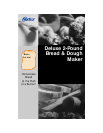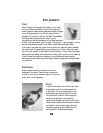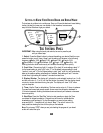
8
LIQUIDS
When liquids are mixed with the proteins in flour,
gluten is formed. Gluten is necessary for rising.
Many recipes use dry milk, but other liquids,
such as fruit juice, beer and water work, too. It’s a
delicate balance: A recipe with too much liquid
may cause the bread to fall during baking while a
recipe with too little liquid will not rise. Water is
the most common liquid used in bread making.
It produces a heavier, crisper crust and a more
open texture. Buttermilk results in a light,
high-rising and tender bread; it will also help
extend the bread’s freshness. To offset the acidity
of buttermilk, add 1/4 cup of baking soda per cup
of buttermilk.
SALT
Salt strengthens the gluten and controls the yeast and
makes the dough more elastic. However, it also inhibits
rising, so use ordinary table salt and be very careful in
measuring. For dietary reasons, it can be omitted and in
some cases you can use a vegetable seasoning substitute
for flavor.
FATS
Any form of solid shortening or oil can be
substituted for one another in some amounts.
Fat enriches bread’s flavor and keeps it tender
and moist. Do not use diet spreads or tub-type
margarines as they will affect the quality.
Butter adds flavor. The same amount of
vegetable shortening or oil can be substituted
if you choose. Salted or unsalted butter
may be used. Soft spreads will NOT work.
Margarine is an acceptable substitute for butter;
do not use whipped or diet margarines.
EGGS
Eggs add richness and color to breads, but due to health and safety precautions,
do not use with the delay cycle.


















